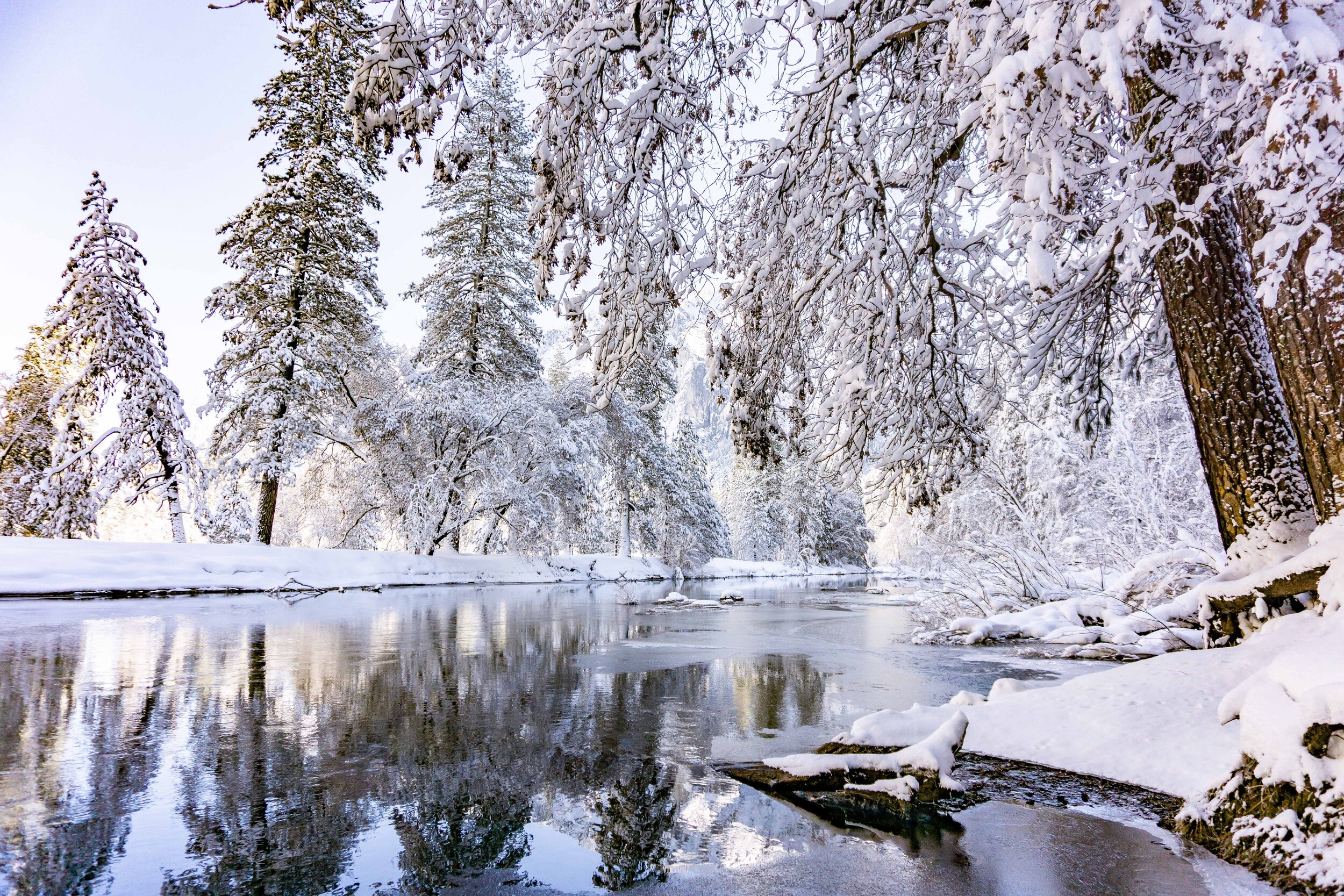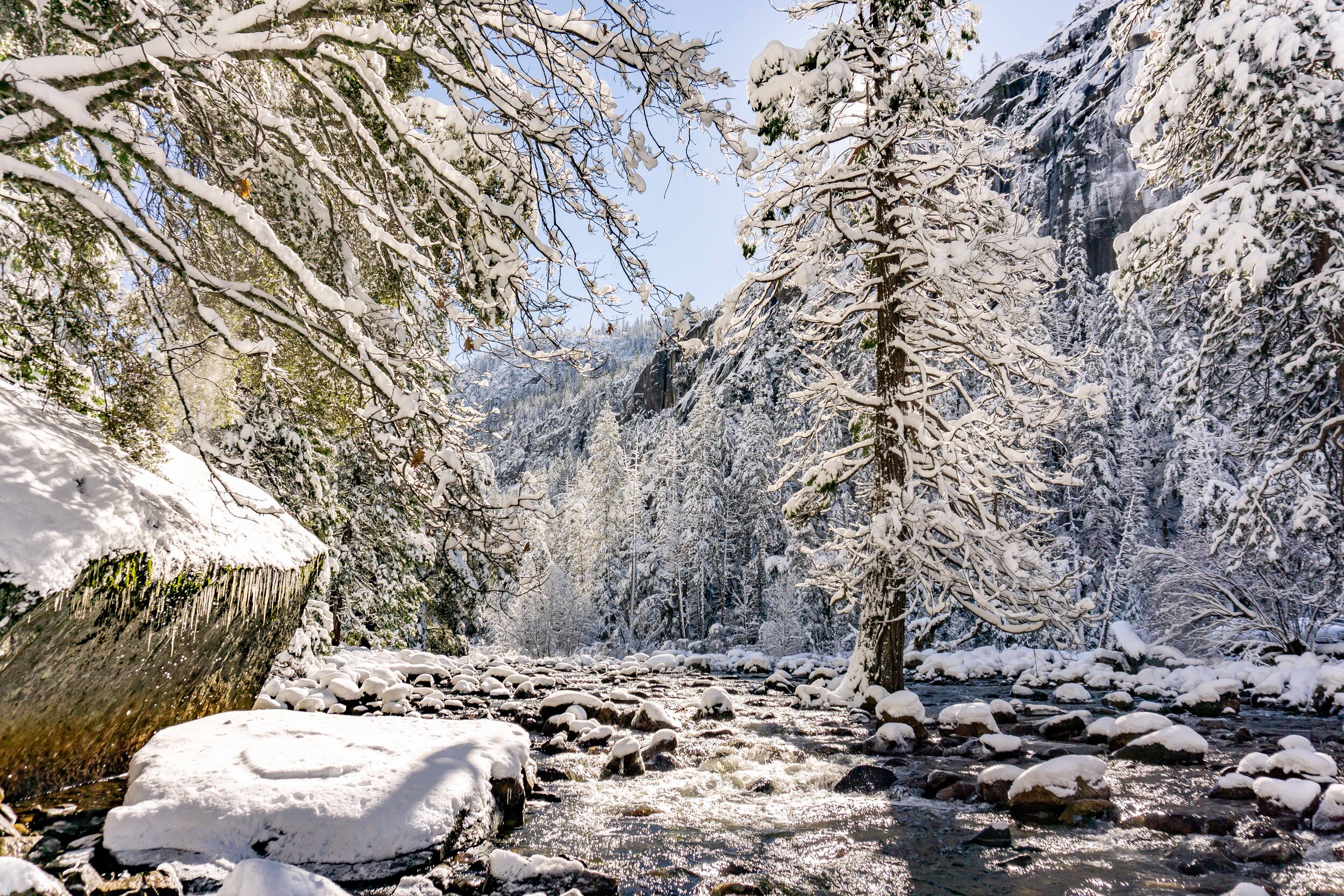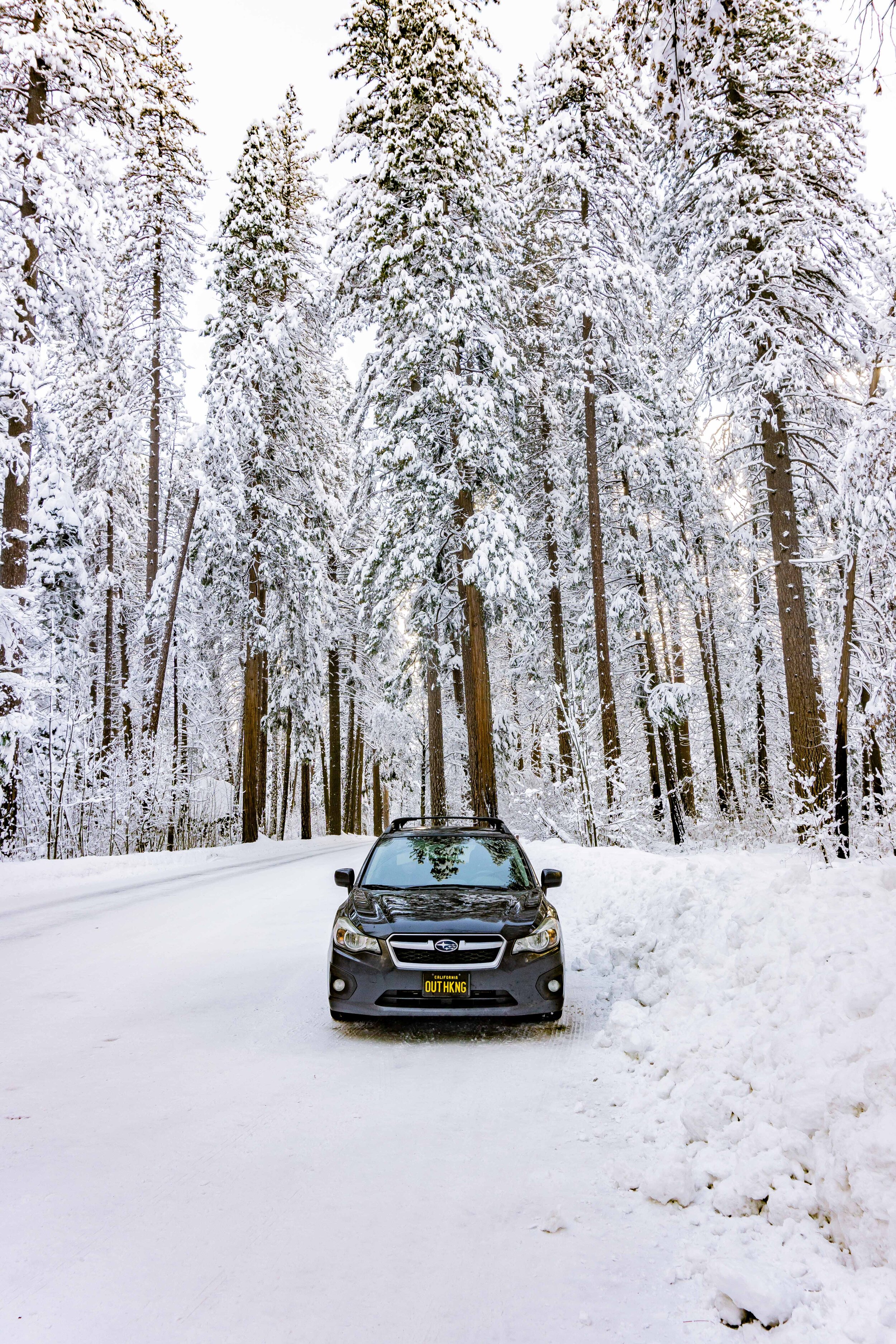Visiting Yosemite National Park in the Winter - Travel Guide
Yosemite National Park is arguably one of the most magical places in the United States and seeing it look like a winter wonderland only adds more magic. I think everyone should try and visit Yosemite in the winter, because it gives you an unique experience as most people visit during the dry months in summer. I’ve visited Yosemite countless times (I grew up 2 hours away from the park) but it wasn’t until February 2019 that I got to experience it in the winter. It was such a beautiful experience and I want to share all the important information you’ll need to have that same experience.
Along the Merced River in Yosemite Valley
Current Conditions - COVID/Weather Related
This section of this blog will be updated as new conditions present themselves. As of right now, the items that may require extra attention when planning a trip during 2021 are:
Reservation System
Winter Closures due to Mono Wind Event and Excessive Snow
Reservation System:
If you are planning to visit Yosemite during February 8 - February 28, you will need a day-use reservation to enter the park. It could be extended out, that is undecided at the moment, I will update the dates once it’s announced. Here’s how the day-use reservations work: First, you will pick an entry date, let’s use February 8th as an example. You MUST enter the park on February 8th to validate your 7 day reservation pass into the park. Meaning if you show up February 9th instead of February 8th, there is a good chance you will be turned away at the gate unless you get lucky (don’t depend on that). If you properly enter the park on the 8th, you will have access to Yosemite for 7 consecutive days so you can get into the park February 8 - 14. You will have access to the park from 5am - 11pm, you cannot be in the park overnight with a day-use reservation, only those with overnight stays or overnight wilderness permit may be in the park overnight during this time.
You will need to get your reservations on Recreation.gov. If you find that your desired entry date is sold out, there is one more chance to get that date. You can try for the remaining reservations that will come available 48 hours before that entry date at 8am pacific time. Those remaining reservations are in smaller quantity, so you’ll want to refresh your page at 8am on the dot and have patience as the website secures your reservation.
You will need to pay a nonrefundable fee of $2.00 to get a day-use reservation, even if you have an annual pass. You can choose an option to pay at the gate or show your annual pass at the gate. If you choose to pay at the gate, please note that they are ONLY accepting credit card payments - no cash.
Other ways that will allow entry to Yosemite:
Upper Pines Campground reservation
Yosemite Valley Lodge or The Ahwahnee reservation
Private lodging or vacation rental reservation in Wawona, Yosemite West, or Foresta
Yosemite wilderness permit
Commercial-use authorization
For more details and information on this topic, you may read Yosemite National Park’s official page on the reservation system here.
Winter Closures due to Mono Wind Event and Excessive Snow
Yosemite National Park experienced a series of winter storms which closed the park from January 19th - February 1st. The storms brought strong winds and heavy, wet snow, causing many hazards to impact park roads, trails, and other facilities. Park road crews have been working hard to mitigate hazards and restore safe conditions for park visitors.
With these closures, you can only enter the park (at this time) via Highway 140 (El Portal) and via Highway 120 from the West (Big Oak Flat). Highway 41 (Wawona) is set to reopen on February 11, weather permitting.
Updates
UPDATE #1 (February 4, 2021) - Highway 120 from the West is now OPEN - the rest of the blog reflects that information as well.
UPDATE #2 (February 6, 2021) - Hetch Hetchy Road is reopened (8AM - 5PM)
Badger Pass Road will open on Monday, February 8, conditions permitting. The Badger Pass Ski Area itself is not operating this year, but parking, portable toilets and wilderness access will be open for those with their own cross-country skis and snowshoes.
Wawona Road (continuation of Highway 41) will fully open (from Yosemite Valley to South Entrance) on Thursday, February 11, conditions permitting. Mariposa Grove remains closed until further notice.
The rest of the blog reflects that information as well
Snowy trees near the El Portal Entrance
Beautiful El Capitan lit up by the morning light
Location
Yosemite National Park is located along the Central Valley of California, near Oakhurst and Groveland. Yosemite can be accessed through four entrances, but only three of the four are open during the winter time. The winter-accessible entrances are Highway 120 from the West (Big Oak Flat), Highway 140 (El Portal), Highway 41 (Wawona). The fourth entrance is Highway 120 from the East (Tioga Pass Entrance), but with its high elevation pass, the highway is closed to the first big snowfall until early summer.
Fees
At one of the entrances, you can buy a 7 day pass ($35), a Yosemite Annual Pass ($70), or a National Park Annual Pass ($80). A National Park Annual Pass would be ideal if you plan on visiting at least one more national park within the year. Here is Yosemite’s website page on fees for more details.
Winter Conditions
Driving/Chain Requirements
Chains may be required at ANY time in the winter, so you must carry tire chains, including 4WD and AWD vehicles. You can buy or rent tire chains outside of the park, snow tires may also be required, depending on what restriction level is enforced (see below). The speed limit when driving with chains is ALWAYS 25 MPH regardless if the speed is posted otherwise, plus driving faster with chains could cause the chains to break and damage your vehicle so I would definitely listen to that rule. There may be Chain Checkpoints where Park Rangers will check that you are carrying tire chains with you, usually during bad weather. They may turn you around or possibly ticket you if there are already chain requirements in place and you are not following those requirements.
Chain Control Levels:
R1: Snow tires or chains are required. This means your tires must have the letters MS, M/S, M+S or the words ‘MUD AND SNOW’ or ‘ALL SEASON’ on the sidewall, or you must install tire chains.
R2: 4-Wheel Drive or Chains are required. This means your vehicle must be in 4x4 or all-wheel drive or you must install chains.
R3: Chains are required on ALL vehicles. This means there are no exceptions, even if you have 4WD or AWD, you're required to put chains on. I’ve only experienced R3 once in my town (Mammoth Lakes) and when it’s that bad, you don’t want to be driving unless you truly need to be.
Always check on the parks’ website to see what the current conditions are, here is a link to their current conditions page.
Snowy road conditions in Yosemite Valley
Snowy road conditions
Yosemite National Park Road/Area Closures + Conditions
Tioga Pass: This road is closed until (usually) May or June, you can find the past closing and opening dates of this pass.
Glacier Point Road: This road is closed for winter until the sometime in the summer, varying every year depending on the snow level. You may drive up to Badger Pass to enjoy snow sports along Glacier Point Road (snowshoeing, skiing, snow tubing, and downhill skiing/snowboarding). Badger Pass Road will open on Monday, February 8, conditions permitting.
Mariposa Grove: This road is closed until sometime in April, allowing for access to vehicles displaying a disability placard, with free shuttle service between the Mariposa Grove Welcome Plaza (near South Entrance) and the Mariposa Grove. When the road is closed, the Washburn Trail provides a two-mile route (500 feet of elevation gain) to the Mariposa Grove. The trail may be snowy or icy (skis or snowshoes may be appropriate). This area is currently inaccessible due to winter storm - see above in Current Conditions at the beginning of the blog (will update as accessibility changes).
Weather/Snow Conditions
Winter weather can vary a lot depending on the snow fall that year, but the one thing that stays generally consistent is how cold it can get. Below are the average temperatures (in Fahrenheit) for November - April:
November: 57° / 32°
December: 48° / 27°
January: 48° / 28°
February: 53° / 30°
March: 58° / 33°
April: 65° / 37°
Snowy weather can happen any time between October - May. The snow doesn’t last too long because of the Valley’s elevation (considered low for snow). Yosemite Valley will usually have snow on the ground for a week or two after a snow storm (depending on how much snow fell). Higher parts of the park that you may hike to will have snow that lasts longer such as the Yosemite Falls, Four Mile Trail and Snow Creek trail hikes. If you’re wanting a snowy experience, I recommend going a few days after a decent sized snow storm (6+ inches). If you go during a snow storm, expect delays and closures while the park clears the roads.
View of snowy Half Dome
What To Do
Winter Hiking
Yosemite Valley: The Valley doesn’t usually have sufficient snow for skiing or snowshoeing, but sometimes conditions will require microspikes or snowshoes in the higher elevations of hikes that start out in the Valley, you can always check with a ranger beforehand to find out the current conditions. I have listed all the hikes accessible in the Valley in the winter.
Lower Yosemite Fall Trail
Cook’s Meadow Loop
Mirror Lake Loop
Valley Loop Trail
Mist Trail/John Muir Trail to Vernal/Nevada Falls
Snow Creek Trail
Four Mile Trail (closed at Union Point in the winter)
Snowshoeing / skiing
Crane Flat (click here for a map and more details): This area is usually high enough elevation that snow will last a while here awhile, allowing for some snowshoeing/skiing, you can always check with a ranger beforehand to find out the current conditions.
Crane Flat Lookout Trail
Tuolumne Grove Trail
Gin Flat Loop Trail
Crane Flat Campground Trail
Clark Range View Trail
South Landing Road Trail
Rockefeller Grove Trail
Merced Grove Trail
Badger Pass/Glacier Point Road (click here for a map and more details): This area usually has snow from November - May, you can always check with a ranger beforehand to find out the current conditions.
Badger Pass Road will open on Monday, February 8, conditions permitting.
Glacier Point Road
Old Glacier Point Road
Dewey Point via Meadows #18
Dewey Point via Ridge #14
Ostrander Lake
Ghost Forest Loop
Downhill Skiing / Snowboarding, Snow Tubing & Sledding
Badger Pass is home to the oldest downhill skiing area in California and offers downhill skiing, snowboarding, and snow tubing/sledding from mid-December through March. This area is currently inaccessible due to winter storm - see above in Current Conditions at the beginning of the blog (will update as accessibility changes).
All facilities and services at Badger Pass will be closed for the winter of 2020/2021, but portable toilets will be available. As conditions allow, Badger Pass Road will be open from approximately mid-December through March. Visitors with their own skis or snowshoes can drive to Badger Pass and go cross-country skiing or snowshoeing. Glacier Point Road will be groomed from Badger Pass to Bridalveil Creek Campground, but not all the way to Glacier Point.
Ice Skating
An outdoor ice skating rink in Yosemite Valley (at Curry Village) is typically open from mid-November to mid-March, but is unfortunately closed this winter 2020/2021 due to COVID.
Near the El Portal Entrance
Where To Stay
In the Park
There are only a few accommodations inside the park during the winter months (and the pandemic), which I have listed below:
The Ahwanhnee (reopens February 5)
Yosemite Valley Lodge (reopens February 5)
Upper Pines Campground (reopens February 8)
Outside of the Park
Near Highway 140 Entrance (El Portal)
The El Portal entrance is closest to the small town of Midpines. This entrance is my first choice to enter the park in the winter because the road is fairly flat and low elevation, which brings the lowest risk of road closure due to snow. Here are a few places I found while researching the area:
Airbnbs
Near Highway 120 Entrance from the West (Big Oak Flat)
The Big Oak Flat entrance is closest to the small town of Groveland. There are a few Airbnb options and a couple hotels/motels around the area. Here are a few places I found while researching the area:
Airbnbs
Near Highway 41 Entrance (Wawona) - this entrance is set to reopen on February 11, weather permitting.The Wawona entrance is closest to the small town of Oakhurst. Oakhurst is about a 25 minute drive to the park entrance and an 1 hour drive to Yosemite Valley. Pay attention to road closures before picking somewhere to stay as Highway 41 may close to winter conditions. Here are a few places I found while researching the area:
View from Pohono Bridge
I hope this travel guide helped you plan a winter trip to Sequoia and/or Kings Canyon National Park or cleared up any confusion you may have had. I think visiting in the winter is a great way to see a different view of the Giant Sequoias and usually with less crowds than the summer, Happy Trails!
Do you have any questions? Feel free to comment below and I’ll help you out!
VIDEOS OF YOSEMITE NATIONAL PARK IN THE WINTER
PIN THIS for later!
Thanks for reading my latest adventure!
Tiare Kirkland
Hi! My name is Tiare, but you can just call me ‘T’. I’m a California based hiker and I spend most of my free time taking photos and videos of some of my favorite hikes. You can usually find me ‘Out Hiking’ in the Sierra Nevada mountain range or road-tripping to new areas. Read more about me here and follow along with my adventures by subscribing below!














